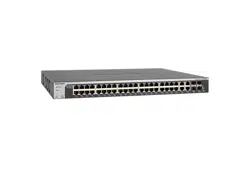Loading ...
Loading ...
Loading ...

Manage Device Security
256
ProSAFE 10-Gigabit Smart Managed Switch XS728T and XS748T User Manual
8. Specify the following settings:
• Port Control. Defines the port authorization state. The control mode is set only if the
link status of the port is link up. Select one of the following options:
- Auto. The system automatically detects the mode of the port.
- Authorized. The system places the port into an authorized state without being
authenticated. The port sends and receives normal traffic without client
port-based authentication.
- Unauthorized. The system denies the selected port system access by moving the
interface into unauthorized state. The switch cannot provide authentication
services to the client through the port.
- MAC based. This mode allows multiple supplicants connected to the same port to
each authenticate individually. Each host connected to the port must authenticate
separately in order to gain access to the network. The hosts are distinguished by
their MAC addresses.
• Dynamic VLAN Assignment. From the menu, select Enable to enable dynamic
VLAN assignment on the port. By default, dynamic VLAN assignment is disabled on
all ports.
This feature is also known as RADIUS Assigned VLAN Attribute (RAVA). If this
feature is enabled, RADIUS servers can assign a VLAN ID to a port based on
802.1 authentication. If a user is authenticated, the user is assigned to this VLAN.
When this feature is enabled on a port, each user is individually authenticated.
• Guest VLAN. From the menu, select Enable to enable the guest VLAN on the port.
By default, the guest VLAN is disabled on all ports. For more information about the
guest VLAN, see Configure Global 802.1X Settings on page 253.
• Periodic Reauthentication. From the menu, select Enable to allow periodic
reauthentication of the supplicant for the port. By default, periodic reauthentication is
disabled and connected clients are not forced to reauthenticate periodically.
• Reauthentication Period. Specify the time, in seconds, after which reauthentication
of the supplicant occurs. The reauthentication period must be a value in the range of
300–4294967295 seconds. The default value is 3600 seconds.
• Quiet Period. Specify the number of seconds that the port remains in the quiet state
following a failed authentication exchange. The valid range is 30–65535, and the
default value is 60 seconds. While in the quite state, the port does not attempt to
acquire a supplicant.
• Resending EAP. Specify the EAP retransmit period for the selected port. The
transmit period is the value, in seconds, after which an EAPoL EAP Request/Identify
frame is resent to the supplicant. The valid range is 30–65535 seconds, and the
default value is 30 seconds.
• Max EAP Requests. Specify the maximum number of EAP requests for the selected
port. The value is the maximum number of times an EAPoL EAP Request/Identity
message is retransmitted before the supplicant times out. The valid range is 1–10,
and the default value is 2.
Loading ...
Loading ...
Loading ...
